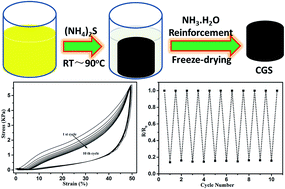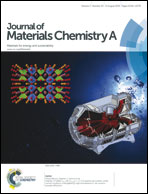A facile method to prepare highly compressible three-dimensional graphene-only sponge†
Abstract
Endowing graphene sponge with compressibility and conductivity offers the possibility to regenerate piezoresistivity and is therefore of great interest in the field of sensors. In this work, highly compressible three-dimensional graphene-only sponge (CGS) was prepared through a facile method by using ammonium sulfide and ammonia solutions under mild conditions. The morphologies and microstructures of the as-prepared CGSs can be controlled by adjusting the mass ratio of graphene oxide (GO) to ammonium sulfide which changed from a metallic sheen bulk with a leaf-shaped structure to a black sponge with a porous structure. Besides, by simply changing the concentrations of GO, CGSs with different porosity, conductivity as well as mechanical strength were obtained. Moreover, the resultant CGSs show ultralow density (as low as 4.9 mg cm−3), high porosity (as much as 99.8%), great compressibility (as much as the strain of 80%), and excellent stability (100 cycles) during compression. Furthermore, the sensitive variation of electrical resistance and cycle stability was validated under the compressive strain of 50% which make CGSs great candidates for pressure-responsive sensors, elastic conductors and other applications.

- This article is part of the themed collection: 2015 Journal of Materials Chemistry A Hot Papers

 Please wait while we load your content...
Please wait while we load your content...